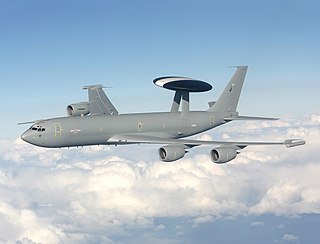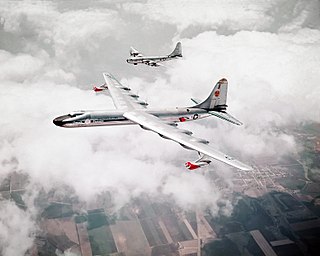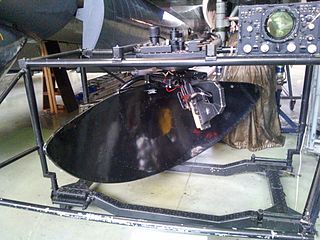Related Research Articles

A bomber is a military combat aircraft designed to attack ground and naval targets by dropping air-to-ground weaponry, launching torpedoes, or deploying air-launched cruise missiles. The first use of bombs dropped from an aircraft occurred in the Italo-Turkish War, with the first major deployments coming in the First World War and Second World War by all major airforces causing devastating damage to cities, towns, and rural areas. The first purpose built bombers were the Italian Caproni Ca 30 and British Bristol T.B.8, both of 1913. Some bombers were decorated with nose art or victory markings.

A military aircraft is any fixed-wing or rotary-wing aircraft that is operated by a legal or insurrectionary armed service of any type. Military aircraft can be either combat or non-combat:

The Douglas A-1 Skyraider is an American single-seat attack aircraft in service from 1946 to the early 1980s. The Skyraider had a remarkably long and successful career; it became a piston-engined anachronism in the jet age, and was nicknamed "Spad", after the French World War I fighter.

USS United States (CVA-58) was to be the lead ship of a new design of aircraft carrier. On 29 July 1948, President Harry Truman approved construction of five "supercarriers", for which funds had been provided in the Naval Appropriations Act of 1949. The keel of the first of the five planned postwar carriers was laid down on 18 April 1949 at Newport News Drydock and Shipbuilding. The program was canceled in 1949, United States was not completed, and the other four planned carriers were never built.

An airborne early warning and control (AEW&C) system is an airborne radar system designed to detect aircraft, ships, vehicles, missiles, and other incoming projectiles at long ranges and perform command and control of the battlespace in an air engagement by directing fighter and attack aircraft strikes. AEW&C units are also used to carry out surveillance, including over ground targets and frequently perform BMC2. When used at altitude, the radar on the aircraft allows the operators to detect and track targets and distinguish between friendly and hostile aircraft much farther away than a similar ground-based radar. Like a ground-based radar, it can be detected by opposing forces, but because of its mobility and extended sensor range, it is much less vulnerable to counter-attacks.

The Distant Early Warning Line, also known as the DEW Line or Early Warning Line, was a system of radar stations in the northern Arctic region of Canada, with additional stations along the north coast and Aleutian Islands of Alaska, in addition to the Faroe Islands, Greenland, and Iceland. It was set up to detect incoming bombers of the Soviet Union during the Cold War, and provide early warning of any sea-and-land invasion.

The Lockheed EC-121 Warning Star was an American airborne early warning and control radar surveillance aircraft operational in the 1950s in both the United States Navy (USN) and United States Air Force (USAF).

The Boeing B-29 Superfortress was an aircraft produced in many experimental and production models.

The AGM-86 ALCM is an American subsonic air-launched cruise missile (ALCM) built by Boeing and operated by the United States Air Force. This missile was developed to increase the effectiveness and survivability of the Boeing B-52H Stratofortress strategic bomber. The missile dilutes an enemy's forces and complicates air defense of its territory.

A nuclear-powered aircraft is a concept for an aircraft intended to be powered by nuclear energy. The intention was to produce a jet engine that would heat compressed air with heat from fission, instead of heat from burning fuel. During the Cold War, the United States and Soviet Union researched nuclear-powered bomber aircraft, the greater endurance of which could enhance nuclear deterrence, but neither country created any such operational aircraft.

The AGM-129 ACM was a low-observable, subsonic, turbofan-powered, air-launched cruise missile originally designed and built by General Dynamics and eventually acquired by Raytheon Missile Systems. Prior to its withdrawal from service in 2012, the AGM-129A was carried exclusively by the US Air Force's B-52H Stratofortress bombers.

The K-class blimp was a class of blimps built by the Goodyear Aircraft Company of Akron, Ohio for the United States Navy. These blimps were powered by two Pratt & Whitney Wasp nine-cylinder radial air-cooled engines, each mounted on twin-strut outriggers, one per side of the control car that hung under the envelope. Before and during World War II, 134 K-class blimps were built and configured for patrol and anti-submarine warfare operations, and were extensively used in the Navy’s anti-submarine efforts in the Atlantic and Pacific Ocean areas.

The N-Class, or as popularly known, the "Nan ship", was a line of non-rigid airships built by the Goodyear Aircraft Company of Akron, Ohio for the US Navy. This line of airships was developed through many versions and assigned various designators as the airship designation system changed in the post World War II era. These versions included airships configured for both anti-submarine warfare and airborne early warning (AEW) missions.

A radar picket is a radar-equipped station, ship, submarine, aircraft, or vehicle used to increase the radar detection range around a nation or military force to protect it from surprise attack, typically air attack, or from criminal activities such as smuggling. By definition a radar picket must be some distance removed from the anticipated targets to be capable of providing early warning. Often several detached radar units would be placed to encircle a target to provide increased cover in all directions; another approach is to position units to form a barrier line.
Kosmos 2479 is a Russian US-KMO missile early warning satellite which was launched in 2012 as part of the Russian Aerospace Defence Forces' Oko programme. The satellite is designed to identify missile launches using infrared telescopes. It was the last US-KMO geostationary satellite, to be launched, prior to the system being replaced by EKS.

The Guardian-class radar picket ships were a class of ocean radar picket ships, converted 1954–1958 from World War II Liberty ships acquired by the U.S. Navy. Their task was to act as part of the radar defenses of the United States in the Cold War, serving until 1965.

The AN/APS-20 was an airborne early warning, anti-submarine, maritime surveillance and weather radar developed in the United States in the 1940s. Entering service in 1945, it served for nearly half a century, finally being retired in 1991. Initially developed at Massachusetts Institute of Technology (MIT) under Project Cadillac, the radar was developed to be carried by aircraft to extend the sensor range of ships by placing a radar at altitude. Although developed for carrier-borne operation, first being installed in the single-engined General Motors TBM-3W Avenger, it was also used in larger four-engined airframes, the last being a fleet of Avro Shackleton AEW.2 which were converted from maritime patrol aircraft. Similarly, although developed for detecting aircraft, it saw extensive service in anti-submarine and maritime patrol roles and was one of the first radars to be used in researching extreme weather like hurricanes by agencies like the Environmental Science Services Administration (ESSA). As well as the United States, the radar was used by a large number of services in other countries, including the French Navy, Japan Maritime Self-Defense Force (JMSDF), Royal Air Force (RAF) and Royal Canadian Air Force (RCAF). Early versions of the radar could see a low-flying aircraft at 65 nautical miles and a ship at 200 nautical miles. This was improved, so that later versions had a range against aerial targets of 115 nautical miles.